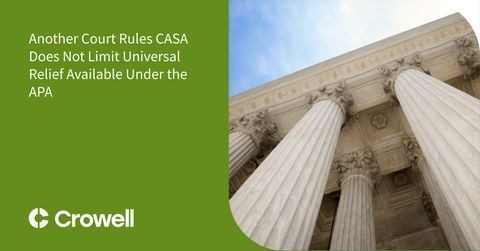Supreme Court Reverses the Ninth Circuit and Restores Order to Clean Water Act Permitting, Rejecting Reallocation of Permitting Authority Over Discharges of "Fill Material" from Corps of Engineers to EPA
Client Alert | 4 min read | 06.22.09
The U.S. Supreme Court today issued its opinion on the division of permitting authority over "fill material" under the Clean Water Act ("CWA") between the U.S. Environmental Protection Agency ("EPA") and the U.S. Army Corps of Engineers ("Corps"). In Coeur Alaska, Inc. v. Southeast Alaska Conservation Council ("SEACC"), the Court held that because the discharge at issue is defined by the agencies' regulations as "fill material," the gold mining operation at issue properly obtained its permit from the Corps under section 404 of the statute, rather than from EPA under the section 402 NPDES permit program. The Court also held that the agencies had properly concluded that EPA's new source performance standards for effluents do not apply to the discharge of fill material.
History of the Case
Petitioner Coeur Alaska sought a permit from the Corps to discharge slurry containing tailings from its froth flotation gold mining operation into a lake. The Corps and EPA concurred that the slurry met the definition of "fill material" under the agencies' regulations because it would have the effect of raising the bottom elevation of the lake, and the Corps granted the permit under section 404, which governs the discharge of "dredged or fill material" under the CWA. SEACC challenged the permit, arguing that the discharge was subject to new source performance standards set by EPA under section 306 of the CWA for the froth-flotation gold mining industry. The district court upheld the permit, holding that if a permit is issued for the disposal of "fill material," then the new source performance standards are inapplicable.
The Ninth Circuit reversed. While it recognized that the proposed discharge met the definition of "fill material," the Ninth Circuit held that the discharge was also subject to the new source performance standard for froth-flotation gold mines and therefore required that any permit be issued by EPA under the NPDES program.
Today's Opinion
The Court held, in a 6-3 decision authored by Justice Kennedy, that the Ninth Circuit had wrongly reallocated the division of responsibility over permits for the discharge of fill material from the Corps to EPA. The Court determined that the CWA is best understood to provide that if the Corps has the authority to issue a permit under section 404, then EPA lacks the authority to do so under the NPDES program. It held that there is no exception to the Corps' authority over discharges of fill material even when such a discharge would otherwise be governed by EPA new source performance standards. The Court appreciated the significant burden that the regulated industry would face if it had to determine not only whether a proposed discharge constitutes "fill material" under the regulations, but also whether it was subject to one of hundreds of EPA effluent standards: "The [CWA] gives no indication that Congress intended to burden industry with that confusing division of permit authority." EPA's role is instead maintained in other ways: the Court recognized that the Corps must consider the environmental consequences of every permit it issues under guidelines written by EPA, and that EPA retains the statutory authority to veto any Corps-issued permit when it determines the effects are unacceptable.
Equally important is the Court's holding that EPA new source performance standards do not apply to discharges of fill material regulated by the Corps. Although it concluded that both the statute and the regulations were ambiguous on this point, the Court accepted the agencies' interpretation, as set forth in an EPA memorandum, that the standards do not apply to fill material. It also recognized that the agencies' past practice weighed against requiring EPA to apply its performance standards to such discharges. The Court concluded that the CWA and regulations did not contemplate that an entity would be required to obtain a permit from both EPA and the Corps, which would create confusion, delay, expense, and uncertainty in the permitting process. The Court determined that the Corps lawfully issued the specific permit in this case, observing that the alternative disposal method would involve the permanent destruction of dozens of acres of wetlands.
Future Implications
Today's decision is a welcome restoration of order to the CWA permitting regime, but a word of caution is appropriate. The Court decided that the statute and regulations are ambiguous on the question whether new source performance standards promulgated under section 306 are applicable to discharges of fill material permitted by the Corps under section 404, and deferred to the agencies' interpretation. Therefore, the decision does not foreclose the possibility that the agencies could change their approach in the future to require discharges of tailings, slurry, and other "fill material" to comply with EPA new source performance standards. The regulated community will need to remain vigilant in maintaining to EPA and the Corps that the existing regulations and permitting requirements for "fill material" best implement the structure and goals of the Clean Water Act.
Click here for a copy of today's opinion. Please contact those listed below.
Contacts
Insights
Client Alert | 3 min read | 01.05.26
Another Court Rules CASA Does Not Limit Universal Relief Available Under the APA
In Trump v. CASA, the Supreme Court significantly constrained the equitable authority of federal district courts to grant universal or nationwide injunctive relief, clarifying that, with specific exceptions, a federal court’s power to grant relief is limited to the parties before it. When it was issued, many bemoaned CASA’s implications for preventing government overreach.
Client Alert | 7 min read | 01.05.26
Consideration of Artificial Intelligence in Arbitration Terms of Reference
Client Alert | 4 min read | 12.31.25
Raising the Bar: New York Expands Consumer Protection Law with FAIR Business Practices Act
Client Alert | 4 min read | 12.30.25




